Effect of the Renin-Angiotensin-Aldosterone System Reactivity on Endothelial Function and Modulative Role of Valsartan in Male Subjects with Essential Hypertension
Abstract
1. Introduction
2. Materials and Methods
2.1. The Bioethics Statement, Protocol Approvals, and Patient Consents
2.2. Study Design and Groups Description
- Vasodilatory function, which is dependent on the nitric oxide (NO) bioavailability resulting from the balance between its synthesis and degradation. The synthesis depends on the substrate availability (l-arginine), as well as on the concentration of the competitive inhibitors for the endothelial nitric oxide synthase (eNOS)—asymmetric and symmetric dimethylarginine (ADMA and SDMA, respectively). The degradation of NO depends mostly on oxidative stress leading to the peroxynitrite formation (ONOO−). Peroxynitrite—as an extremely unstable compound—leads to the nitration and S-nitrosylation of numerous proteins, and the nitrotyrosine (N-Tyr) is a marker of nitrosative stress. The bioavailability of nitric oxide was assessed also at the functional level by measuring the flow-mediated vasodilation (FMD) of the brachial artery.
- Oxidative stress, measured as the lipid peroxidation, where malonyldialdehyde (MDA) is a marker, and nitrosative stress, as described above. Moreover, the antioxidative glutathione capacity was measured and expressed as the reduced-to-oxidized glutathione ratio (thiol index).
- Inflammatory and angiogenic function regulated by oxidative stress, which was expressed by measuring the release of cell adhesion molecules (ICAM-1, VCAM-1), E-selectin, as well as of the vascular endothelial growth factor (VEGF).
- Expression of the cyclooxygenase (COX) metabolic pathway, by measuring the arachidonic acid cascade end-products (thromboxane B2—TxB2, and prostacyclin—6-keto-PGF1 alpha). The parameters analyzed in this study are marked in red in Figure 1.
2.3. Blood Collection and Storage for Laboratory Assays
- Plasma metabolites of NO pathway (ADMA, SDMA, l-Arg)—for subsequent high-performance liquid chromatography (HPLC) analysis;
- Plasma prostanoids levels (TxB2 reflecting platelet COX-dependent activation, and 6-keto-PGF1 alpha reflecting endothelial antiaggregatory activation—for subsequent immunoenzymatica assays (EIA));
- Plasma markers of oxidative stress (MDA—lipid peroxidation, GSH, GSSG, thiol index—GSH/GSSG—antioxidative capacity, and N-tyrosine—nitrosative stress from the eNOS uncoupling—marker of peroxynitrite formation);
- Pro-inflammatory/angiogenic endothelial parameters (sICAM-1, sVCAM-1, PAI-1, sE-selectin, PAI-1, VEGF)—for subsequent immunoenzymatic assays (EIA);
- Serum concentrations of total cholesterol (TCh), low-density lipoprotein (LDL), high-density lipoprotein (HDL), triglycerides (Tg), high-sensitive C-reactive protein (hsCRP), urea, creatinine, plasma glucose, thyroid stimulating hormone (TSH), sodium (Na+), potassium (K+), and uric acid (UA);
- Aldosterone concentration and plasma renin activity.
2.4. Determination of Selected Parameters Characterizing the Endothelial Function
2.5. Measurements of the Endothelial Vasodilatory Function (FMD)
2.6. Measurements of Arterial Stiffness
2.7. Statistical Analysis
3. Results
3.1. Baseline Demographic Characteristics
3.2. Selected Parameters of the RAA System
3.3. FMD
3.4. Selected Parameters of the NO Bioavailability and Nitrosative Stress
3.5. Markers of Oxidative Stress
3.6. Markers of Inflammatory, Angiogenic, and Thrombogenic Function
3.6.1. Endothelial Inflammatory Function—The Concentrations of sICAM-1 and sVCAM 1 and sE-Selectin
3.6.2. Endothelial Angiogenic Function—Analyzing the VEGF Concentrations
3.6.3. Endothelial Thrombogenic Function—The PAI-1, 6-keto-PGF1 Alpha, and Thromboxane B6 Levels
3.6.4. Effect of Pharmacological Interventions on Endothelial Inflammatory, Angiogenic, and Thrombogenic Function—Summary
4. Discussion
5. Conclusions
6. Limitations
Author Contributions
Funding
Institutional Review Board Statement
Informed Consent Statement
Data Availability Statement
Conflicts of Interest
References
- Miura, S. Angiotensin II Receptor Research. Curr. Pharm. Des. 2013, 19, 2979–2980. [Google Scholar] [CrossRef] [PubMed]
- Weber, M.A. Interrupting the renin-angiotensin system: The role of angiotensin-converting enzyme inhibitors and angiotensin II receptor antago-nists in the treatment of hypertension. Am. J. Hypertens. 1999, 12, 189S–194S. [Google Scholar] [CrossRef]
- Paul, M.; Mehr, A.P.; Kreutz, R. Physiology of Local Renin-Angiotensin Systems. Physiol. Rev. 2006, 86, 747–803. [Google Scholar] [CrossRef]
- Jaffe, E.A. Cell biology of endothelial cells. Hum. Pathol. 1987, 18, 234–239. [Google Scholar] [CrossRef]
- Cines, D.B.; Pollak, E.S.; Buck, C.A.; Loscalzo, J.; Zimmerman, G.A.; McEver, R.P.; Pober, J.S.; Wick, T.; Konkle, B.A.; Schwartz, B.S.; et al. Endothelial cells in physiology and in the pathophysiology of vascular disorders. Blood 1998, 91, 3527–3561. [Google Scholar]
- Cahill, P.; Redmond, E.M. Vascular endothelium—Gatekeeper of vessel health. Atherosclerosis 2016, 248, 97–109. [Google Scholar] [CrossRef] [PubMed]
- Blanco-Rivero, J.; Cachofeiro, V.; Lahera, V.; Aras-Lopez, R.; Marquez-Rodas, I.; Salaices, M.; Xavier, F.; Ferrer, M.; BalfagoÓn, G. Participation of Prostacyclin in Endothelial Dysfunction Induced by Aldosterone in Normotensive and Hypertensive Rats. Hypertension 2005, 46, 107–112. [Google Scholar] [CrossRef]
- Davis, K.; Ginsburg, R.; Bristow, M.R.; Harrison, D.C. Biphasic action of prostacyclin in the human coronary artery (Abstract). Clin. Res. 1980, 28, 165A. [Google Scholar]
- Gluais, P.; Lonchampt, M.; Morrow, J.D.; Vanhoutte, P.M.; Feletou, M. Acetylcholine-induced endothelium-dependent contractions in the SHR aorta: The Janus face of prostacyclin. Br. J. Pharmacol. 2005, 146, 834–845. [Google Scholar] [CrossRef] [PubMed]
- Husain, S.; Andrews, N.P.; Mulcahy, D.; Panza, J.A.; Quyyumi, A.A. Aspirin improves endothelial dysfunction in atherosclerosis. Circulation 1998, 97, 716–720. [Google Scholar] [CrossRef]
- Delles, C.; Schneider, M.P.; John, S.; Gekle, M.; Schmieder, R.E. Angiotensin converting enzyme inhibition and angiotensin II AT1-receptor block-ade reduce the levels of asymmetrical N(G), N(G)-dimethylarginine in human essential hypertension. Am. J. Hypertens. 2002, 15, 590–593. [Google Scholar] [CrossRef][Green Version]
- Ito, A.; Egashira, K.; Narishige, T.; Muramatsu, K.; Takeshita, A. Renin-Angiotensin System is Involved in the Mechanism of Increased Serum Asymmetric Dimethylarginine in Essential Hypertension. Jpn. Circ. J. 2001, 65, 775–778. [Google Scholar] [CrossRef] [PubMed]
- Napoli, C.; Sica, V.; de Nigris, F.; Pignalosa, O.; Condorelli, M.; Ignarro, L.; Liguori, A. Sulfhydryl angiotensin-converting enzyme inhibition induces sustained reduction of systemic oxidative stress and improves the nitric oxide pathway in patients with essential hypertension. Am. Heart J. 2004, 148, 172. [Google Scholar] [CrossRef]
- Conen, D.; Everett, B.M.; Glynn, R.J.; Ridker, P.M. Effect of valsartan compared with valsartan/hydrochlorothiazide on plasma levels of cellular adhesion molecules: The Val-MARC trial. Heart 2008, 94, e13. [Google Scholar] [CrossRef]
- Johns, M.W. A New Method for Measuring Daytime Sleepiness: The Epworth Sleepiness Scale. Sleep 1991, 14, 540–545. [Google Scholar] [CrossRef]
- Netzer, N.C.; Stoohs, R.A.; Netzer, C.M.; Clark, K.; Strohl, K.P. Using the Berlin Questionnaire To Identify Patients at Risk for the Sleep Apnea Syndrome. Ann. Intern. Med. 1999, 131, 485–491. [Google Scholar] [CrossRef]
- Mach, F.; Baigent, C.; Catapano, A.L.; Koskinas, K.C.; Casula, M.; Badimon, L.; Chapman, M.J.; De Backer, G.G.; Delgado, V.; Ference, B.A.; et al. 2019 ESC/EAS Guidelines for the management of dyslipidaemias: Lipid modification to reduce cardiovas-cular risk. Eur. Heart J. 2020, 41, 111–188. [Google Scholar] [CrossRef]
- Doroszko, A.; Andrzejak, R.; Szuba, A. Role of the nitric oxide metabolic pathway and prostanoids in the pathogenesis of endothelial dysfunc-tion and essential hypertension in young men. Hypertens. Res. 2011, 34, 79–86. [Google Scholar] [CrossRef][Green Version]
- Boger, R.H.; Bode-Boger, S.M.; Szuba, A.; Tsao, S.; Chan, J.R.; Tangphao, O.; Blaschke, T.F.; Cooke, J.P. Asymmetric dimethylarginine (ADMA): A novel risk factor for endothelial dysfunction: Its role in hypercholesterolemia. Circulation 1998, 98, 1842–1847. [Google Scholar] [CrossRef]
- Esterbauer, H.; Schaur, R.J.; Zollner, H. Chemistry and biochemistry of hydroxynonenal, malonyldialdehydeand related aldehydes. Free Rad. Biol. Med. 1991, 11, 81–128. [Google Scholar] [CrossRef]
- Guntherberg, H.; Rost, J. The true oxidized glutathione content of red blood cells obtained by new enzymatic and paper chromatographic methods. Anal. Biochem. 1966, 15, 205–210. [Google Scholar] [CrossRef]
- Celermajer, D.S.; Sorensen, K.E.; Gooch, V.M.; Spiegelhalter, D.J.; Miller, O.I.; Sullivan, I.D.; Lloyd, J.K.; Deanfield, J.E. Non-invasive detection of endo-thelial dysfunction in children and adults at risk of atherosclerosis. Lancet 1992, 340, 1111–1115. [Google Scholar] [CrossRef]
- Gawryś, J.; Gawrys, K.; Szahidewicz-Krupska, E.; Derkacz, A.; Mochol, J.; Doroszko, A. Interactions between the Cyclooxygenase Metabolic Pathway and the Renin-Angiotensin-Aldosterone Systems: Their Effect on Cardiovascular Risk, from Theory to the Clinical Practice. BioMed Res. Int. 2018, 2018, 7902081. [Google Scholar] [CrossRef]
- Riegger, G.A.; Kahles, H.W.; Elsner, D.; Kromer, E.P.; Kochsiek, K. Effects of acetylsalicylic acid on renal function in patients with chronic heart failure. Am. J. Med. 1991, 90, 571–575. [Google Scholar] [CrossRef]
- Nishizaka, M.K.; Zaman, M.A.; Green, S.A.; Renfroe, K.Y.; Calhoun, D.A. Impaired endothelium-dependent flow-mediated vasodilation in hyper-tensive subjects with hyperaldosteronism. Circulation 2004, 109, 2857–2861. [Google Scholar] [CrossRef] [PubMed]
- Tzemos, N.; Lim, P.O.; Macdonald, T.M. Valsartan Improves Endothelial Dysfunction in Hypertension: A Randomized, Double-Blind Study. Cardiovasc. Ther. 2009, 27, 151–158. [Google Scholar] [CrossRef]
- Hirooka, Y.; Kimura, Y.; Sagara, Y.; Ito, K.; Sunagawa, K. Effects of Valsartan or Amlodipine on Endothelial Function and Oxidative Stress after One Year Follow-up in Patients with Essential Hypertension. Clin. Exp. Hypertens. 2008, 30, 267–276. [Google Scholar] [CrossRef]
- Schiffrin, E.L.; Park, J.B.; Intengan, H.D.; Touyz, R.M. Correction of Arterial Structure and Endothelial Dysfunction in Human Essential Hypertension by the Angiotensin Receptor Antagonist Losartan. Circulation 2000, 101, 1653–1659. [Google Scholar] [CrossRef] [PubMed]
- Kosch, M.; Levers, A.; Lang, D.; Bartels, V.; Rahn, K.H.; Pavenstädt, H.; Hausberg, M. A randomized, double-blind study of valsartan versus metoprolol on arterial distensibility and endothelial function in essential hypertension. Nephrol. Dial. Transplant. 2008, 23, 2280–2285. [Google Scholar] [CrossRef] [PubMed]
- Klingbeil, A.U.; John, S.; Schneider, M.P.; Jacobi, J.; Handrock, R.; Schmieder, R.E. Effect of AT1 receptor blockade on endothelial function in essential hypertension. Am. J. Hypertens. 2003, 16, 123–128. [Google Scholar] [CrossRef][Green Version]
- Takiguchi, S.; Ayaori, M.; Uto-Kondo, H.; Iizuka, M.; Sasaki, M.; Komatsu, T.; Takase, B.; Adachi, T.; Ohsuzu, F.; Ikewaki, K. Olmesartan improves endothelial function in hypertensive patients: Link with extracellular superoxide dismutase. Hypertens. Res. 2011, 34, 686–692. [Google Scholar] [CrossRef]
- Osunkalu, V.O.; Taiwo, I.A.; Makwe, C.C.; Akinsola, O.J.; Quao, R.A. Methylenetetrahydrofolate Reductase Enzyme Level and Antioxidant Activity in Women with Gestational Hypertension and Pre-eclampsia in Lagos, Nigeria. J. Obstet. Gynecol. India 2019, 69, 317–324. [Google Scholar] [CrossRef] [PubMed]
- Verma, M.K.; Jaiswal, A.; Sharma, P.; Kumar, P.; Singh, A.N. Oxidative stress and biomarker of TNF-α, MDA and FRAP in hypertension. J. Med. Life 2019, 12, 253–259. [Google Scholar] [CrossRef] [PubMed]
- Tian, X.Y.; Wong, W.T.J.; Leung, F.P.; Zhang, Y.; Wang, Y.-X.; Lee, H.K.; Ng, C.-F.; Chen, Z.Y.; Yao, X.; Au, C.L.; et al. Oxidative Stress-Dependent Cyclooxygenase-2-Derived Prostaglandin F2α Impairs Endothelial Function in Renovascular Hypertensive Rats. Antioxid. Redox Signal. 2012, 16, 363–373. [Google Scholar] [CrossRef]
- Srivastava, K.; Chandra, S.; Narang, R.; Bhatia, J.; Saluja, D. E-selectin gene in essential hypertension: A case-control study. Eur. J. Clin. Investig. 2018, 48, e12868. [Google Scholar] [CrossRef] [PubMed]
- Nomura, S.; Shouzu, A.; Omoto, S.; Nishikawa, M.; Fukuhara, S.; Iwasaka, T. Effect of valsartan on monocyte/endothelial cell activation markers and adiponectin in hypertensive patients with type 2 diabetes mellitus. Thromb. Res. 2006, 117, 385–392. [Google Scholar] [CrossRef]
- Pool, J.; Glazer, R.; Chiang, Y.-T.; Gatlin, M. Dose-response efficacy of valsartan, a new angiotensin II receptor blocker. J. Hum. Hypertens. 1999, 13, 275–281. [Google Scholar] [CrossRef] [PubMed][Green Version]
- Oparil, S.; Dyke, S.; Harris, F.; Kief, J.; James, D.; Hester, A.; Fitzsimmons, S. The efficacy and safety of valsartan compared with placebo in the treatment of patients with essential hypertension. Clin. Ther. 1996, 18, 797–810. [Google Scholar] [CrossRef]
- Verdecchia, P. Assessment of the optimal daily dose of valsartan in patients with hypertension, heart failure, or both. Clin. Ther. 2004, 26, 460–472. [Google Scholar] [CrossRef]
- Zhou, G.; Cheung, A.K.; Liu, X.; Huang, Y. Valsartan slows the progression of diabetic nephropathy in db/db mice via a reduction in podocyte injury, and renal oxidative stress and inflammation. Clin. Sci. 2014, 126, 707–720. [Google Scholar] [CrossRef]
- Feng, T.C.; Ying, W.Y.; Hua, R.J.; Ji, Y.Y.; de Gasparo, M. Effect of valsartan and captopril in rabbit carotid injury. Possible involvement of brady-kinin in the antiproliferative action of the renin-angiotensin blockade. J. Renin Angiotensin Aldosterone Syst. 2001, 2, 19–24. [Google Scholar] [CrossRef] [PubMed]
- Erbaş, B.; Üresin, Y.; Özek, M.; Doğru-Abbasoğlu, S.; Üresin, Y. Effects of valsartan on stress-induced changes of serum vascular endothelial growth factor and nitric oxide in mice. Int. J. Neurosci. 2006, 116, 601–611. [Google Scholar] [CrossRef] [PubMed]
- Song, S.-M.; Wang, C.-C.; Qi, S.-H.; Xing, L.; Yang, B.-F.; Oite, T.; Li, B. Angiotensin receptor blockade attenuates glomerulosclerosis progression by promoting VEGF expression and bone marrow-derived cells recruitment. Nephrol. Dial. Transplant. 2011, 27, 2712–2719. [Google Scholar] [CrossRef] [PubMed]
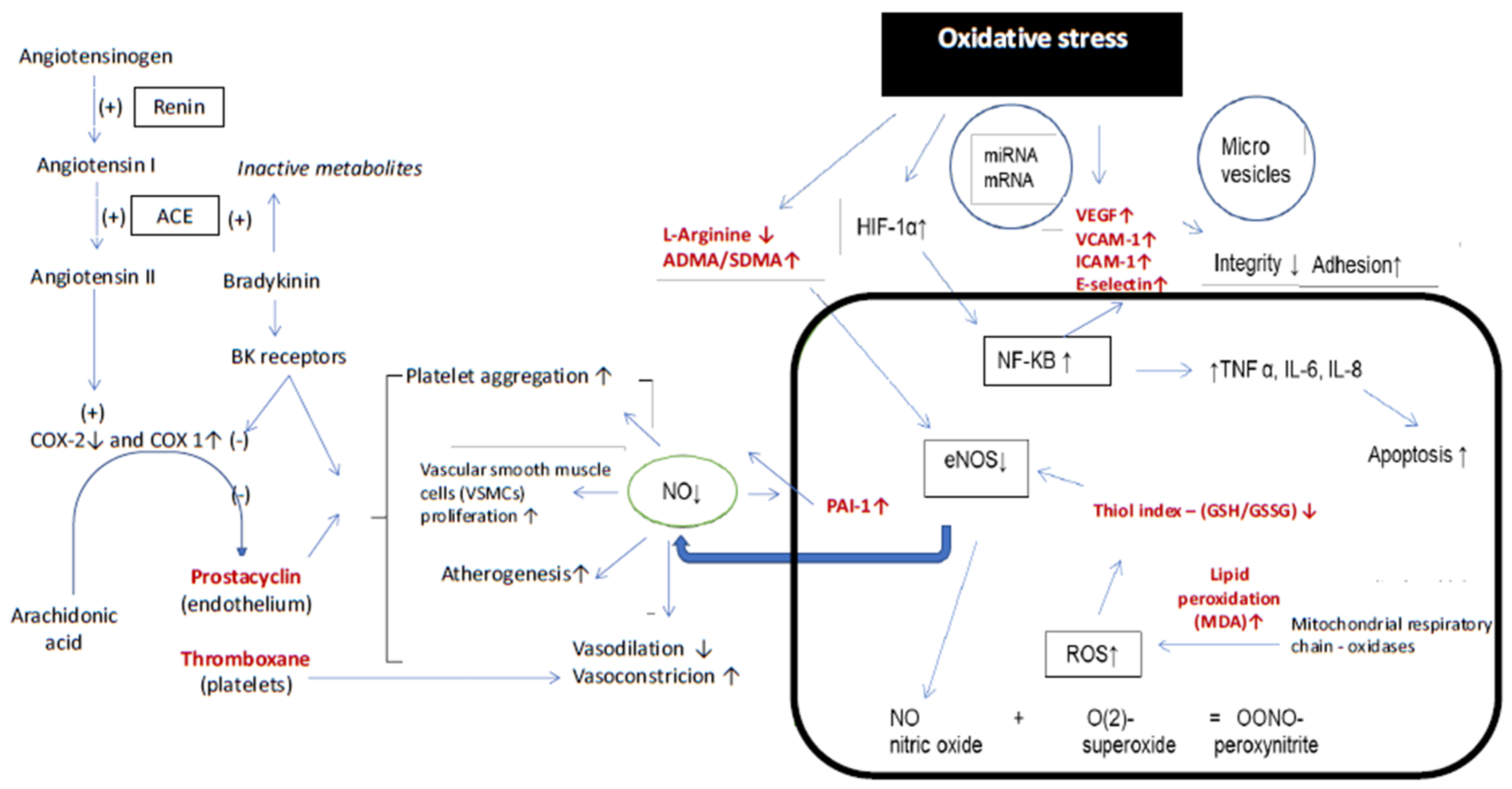
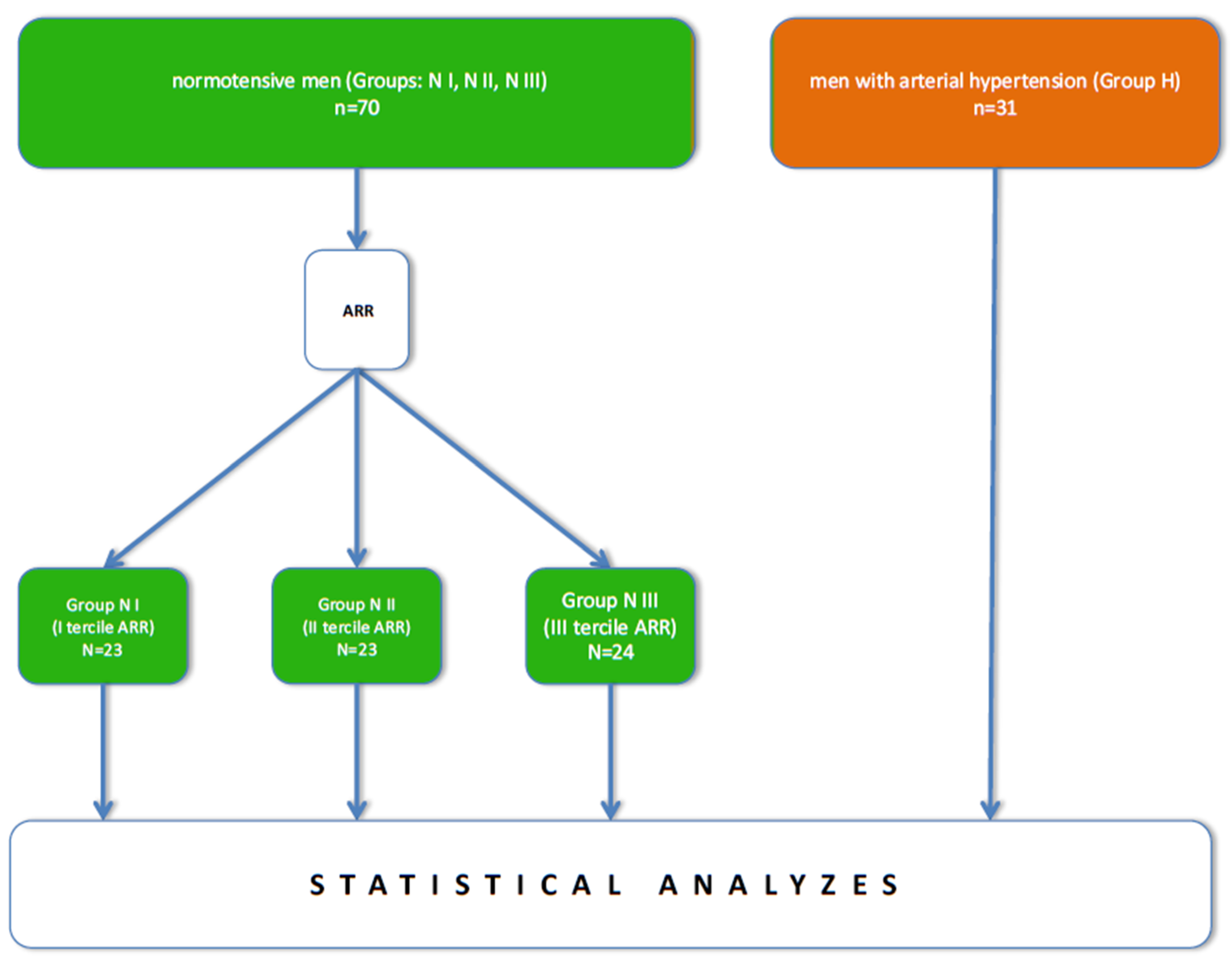
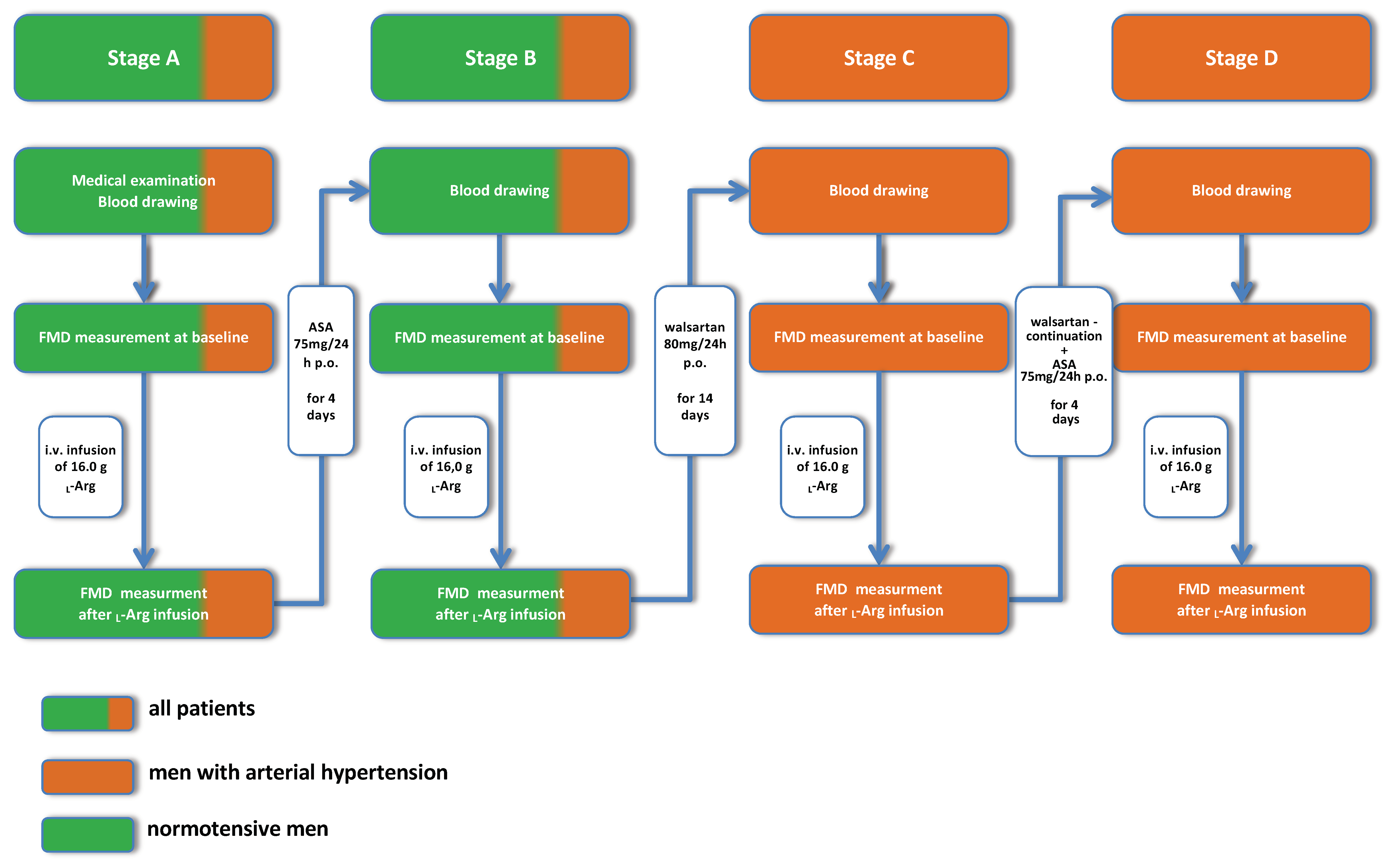
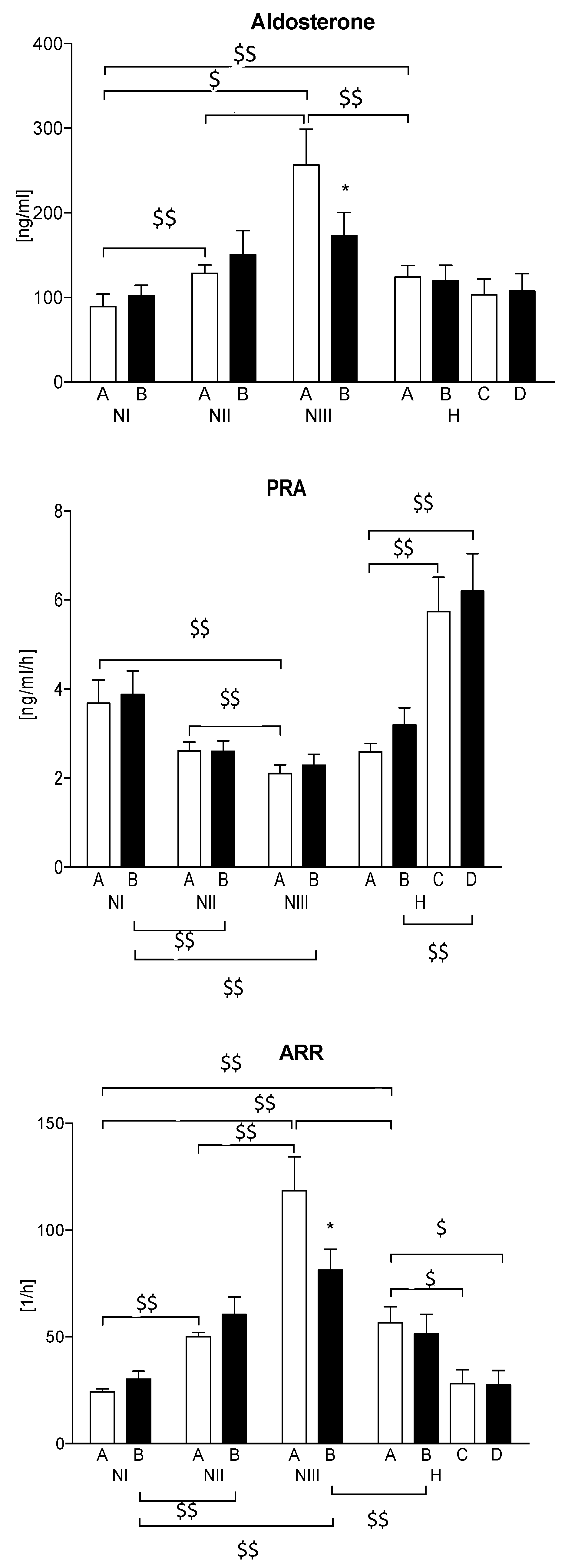
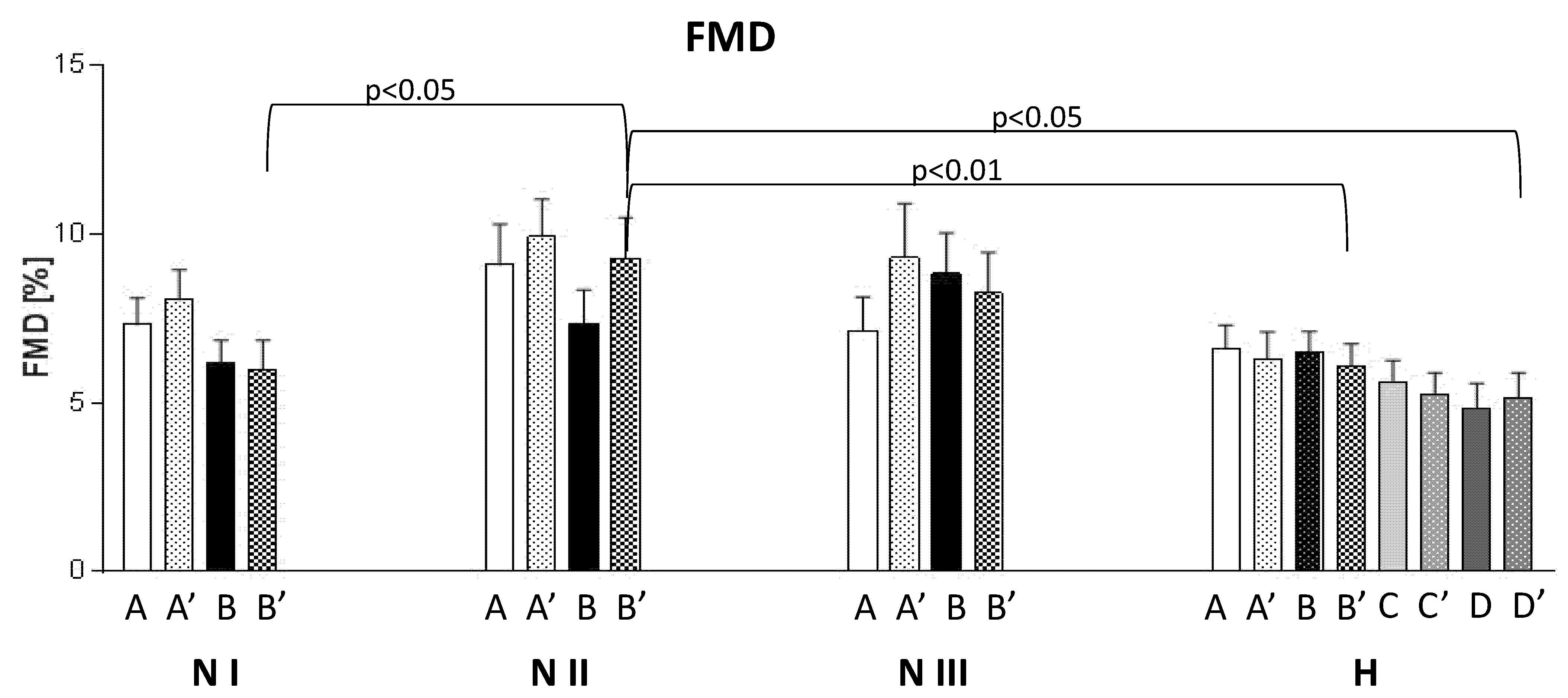
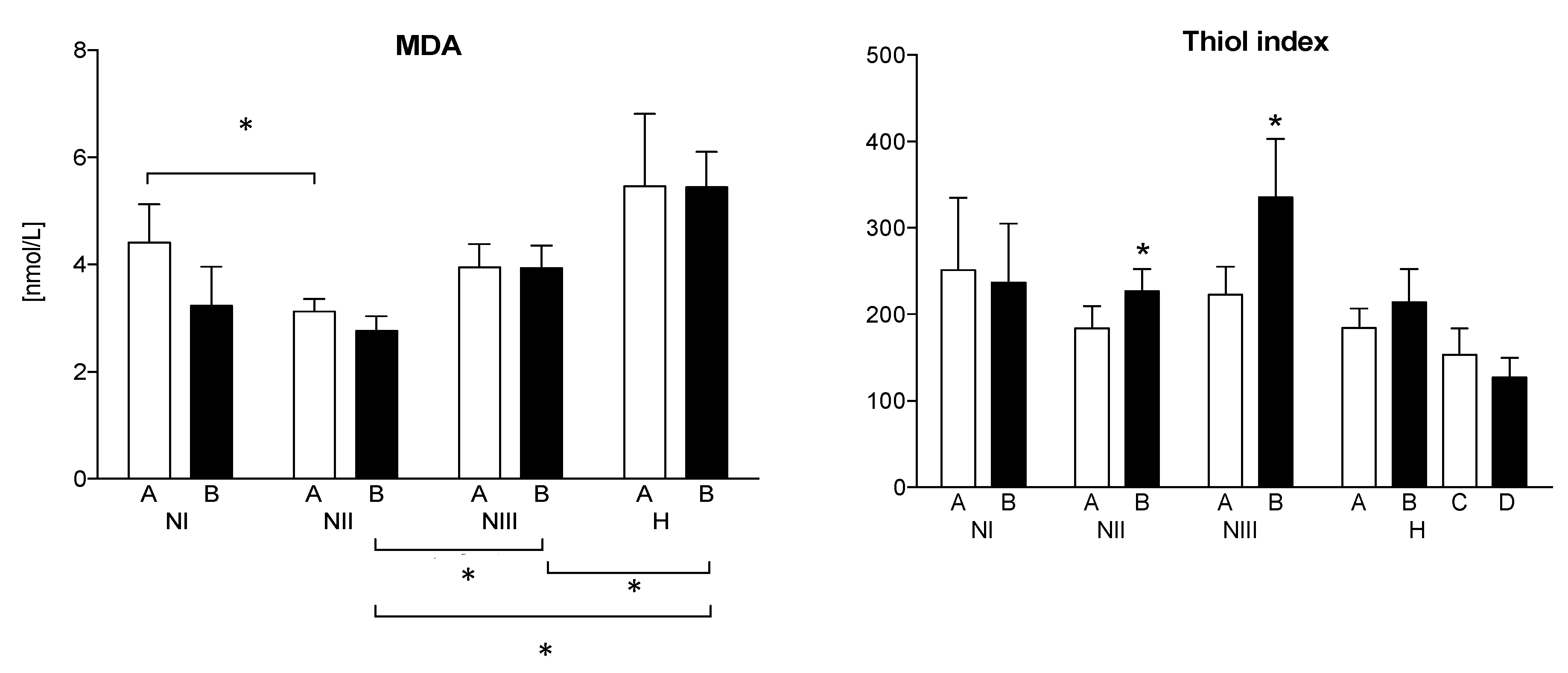
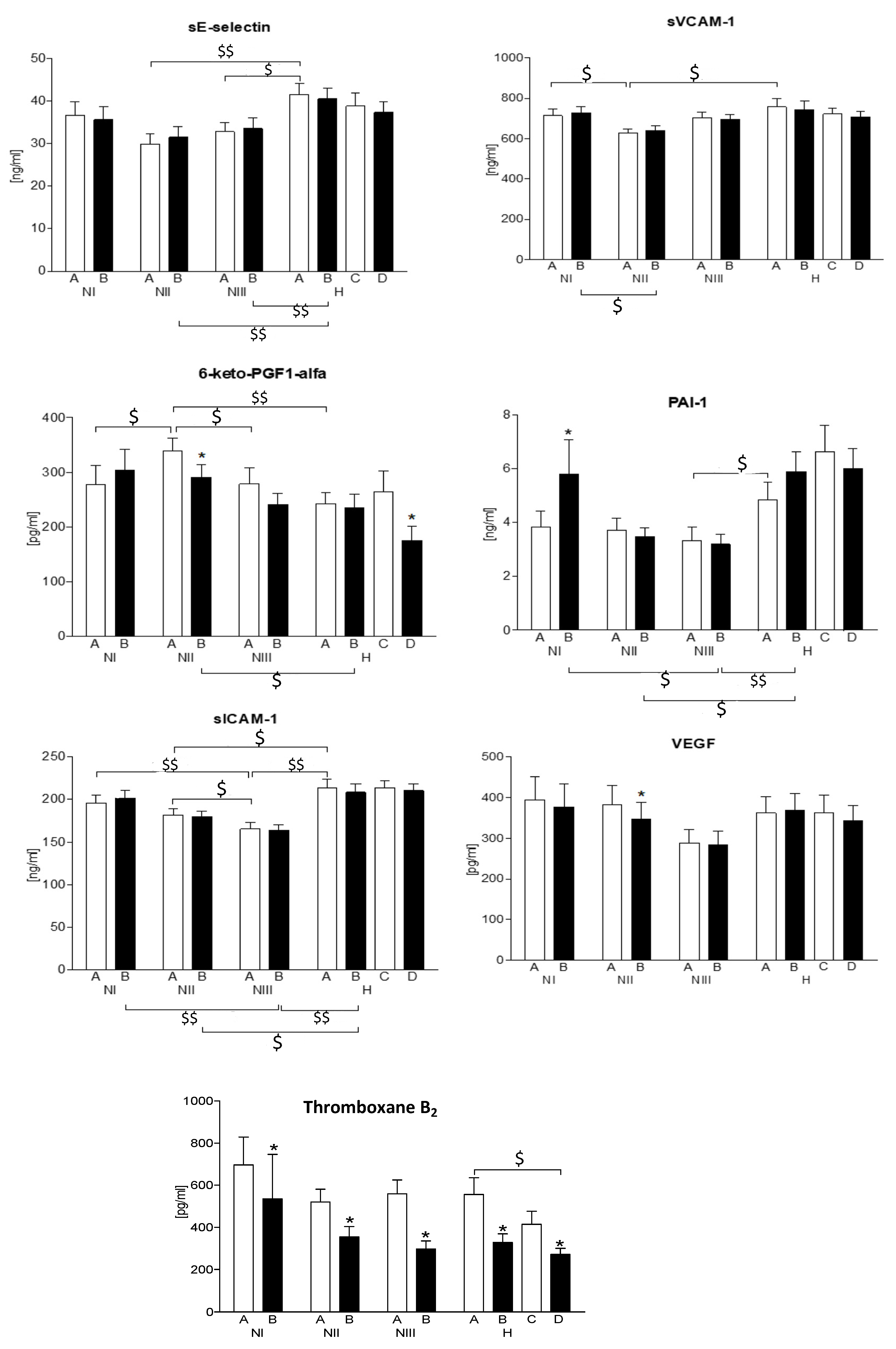
| I Tercile ARR (NI) | II Tercile ARR (NII) | III Tercile ARR (NIII) | Arterial Hypertension (H) | p Value | |
|---|---|---|---|---|---|
| Mean ± SD | Mean ± SD | Mean ± SD | Mean ± SD | ||
| N | 23 | 23 | 24 | 31 | |
| Age (years) | 28.2 ± 1.21 | 26.83 ± 1.16 | 25.13 ± 0.87 | 27.37 ± 0.75 | ns |
| HR (min−1) | 70.5 ± 2.88 | 71.47 ± 2.26 | 70.78 ± 2.5 | 77.0 ± 3.0 | ns |
| SBP (mmHg) | 132.14 ± 4.59 | 127.78 ± 3.11 | 129.52 ± 2.51 | 145.85 ± 4.12 | 0.0009 *#$ |
| DBP (mmHg) | 80.71 ± 2.51 | 83.61 ± 2.09 | 84.04 ± 1.83 | 88.60 ± 2.65 | ns |
| MAP (mmHg) | 97.86 ± 3.14 | 98.33 ± 2.15 | 99.2 ± 1.85 | 107.68 ± 2.82 | 0.0106 *#$ |
| PP (mmHg) | 51.43 ± 2.48 | 44.17 ± 2.63 | 45.48 ± 2.04 | 57.25 ± 3.26 | 0.0044 #$&% |
| Height (cm) | 179 ± 1.94 | 180.68 ± 1.51 | 181.7 ± 1.17 | 180.61 ± 1.17 | ns |
| Weight (kg) | 82.88 ± 4.05 | 86.5 ± 1.99 | 85.39 ± 1.7 | 83.61 ± 2.88 | ns |
| BMI (kg/m2) | 25.76 ± 0.95 | 26.56 ± 0.64 | 25.88 ± 0.51 | 25.57 ± 0.77 | ns |
| WHR | 0.95 ± 0.02 | 0.94 ± 0.01 | 0.94 ± 0.01 | 0.95 ± 0.03 | ns |
| PWV C-F (m/s) | 9.64 ± 0.34 | 9.83 ± 0.34 | 9.79 ± 0.31 | 10.58 ± 0.37 | ns |
| TCh (mg/dL) | 186.18 ± 7.93 | 177.29 ± 11.38 | 174.16 ± 6.7 | 191.41 ± 7.47 | ns |
| HDL-C (mg/dL) | 47.09 ± 1.67 | 52.29 ± 2.13 | 56.26 ± 2.83 | 50.00 ± 2.03 | 0.0417 & |
| LDL-C (mg/dL) | 108.71 ± 7.6 | 97.89 ± 9.78 | 91.05 ± 6.99 | 116.90 ± 6.31 | 0.0485 #$ |
| TG (mg/dL) | 154.62 ± 21.96 | 144.67 ± 15.98 | 134.53 ± 16.31 | 122.62 ± 13.32 | ns |
| hs-CRP (mg/L) | 2.57 ± 0.49 | 2.94 ± 0.36 | 3.2 ± 0.28 | 2.00 ± 0.60 | 0.0081 #$ |
| Glucose (mg/dL) | 81.05 ± 1.68 | 86.09 ± 1.87 | 84.58 ± 2.75 | 91.61 ± 1.48 | 0.0012 *#% |
| Creatinine (mg/dL) | 0.98 ± 0.02 | 0.98 ± 0.03 | 0.99 ± 0.03 | 1.05 ± 0.02 | ns |
| eGFR (ml/min/1.73 m2) | 128.83 ± 11.03 | 141.3 ± 5.55 | 137.5 ± 5.39 | 111.44 ± 7.54 | 0.0049 #$ |
| Uric acid (mg/dL) | 6.08 ± 0.25 | 6.24 ± 0.28 | 5.94 ± 0.31 | 6.02 ± 0.22 | ns |
| Urea (mmol/L) | 31.57 ± 1.59 | 34.3 ± 1.85 | 32.5 ± 1.56 | 30.18 ± 1.23 | ns |
| Sodium (mmol/L) | 140.86 ± 0.57 | 141.91 ± 0.38 | 141.37 ± 0.41 | 139.93 ± 0.43 | 0.0121 #$ |
| Potassium (mmol/L) | 4.01 ± 0.06 | 4.1 ± 0.07 | 4.0 ± 0.07 | 4.21 ± 0.06 | ns |
| ARR baseline (A) | 24.27 ± 1.14 | 50.17 ± 1.81 | 118.15 ± 15.1 | 56.51 ± 6.11 | <0.0001 *$&% |
| I Tercile ARR (NI) | II Tercile ARR (NII) | III Tercile ARR (NIII) | Arterial Hypertension (H) | p | |
|---|---|---|---|---|---|
| Mean ± SD | Mean ± SD | Mean ± SD | Mean ± SD | ||
| SBP A (mmHg) | 132.14 ± 4.59 | 127.78 ± 3.11 | 129.52 ± 2.51 | 145.85 ± 4.12 | 0.0009 *#$ |
| vs. | vs. | vs. | vs. | ||
| SBP end (mmHg) | 130.00 ± 3.94 | 127.51 ± 4.91 | 128.26 ± 3.31 | 135.35 ± 3.80 | ns |
| p = ns | p = ns | p = ns | p = 0.00018 | ||
| DBP A (mmHg) | 80.71 ± 2.51 | 83.61 ± 2.09 | 84.04 ± 1.83 | 88.60 ± 2.65 | ns |
| vs. | vs. | vs. | vs. | ||
| DBP end (mmHg) | 82.27 ± 2.11 | 82.50 ± 2.04 | 82.17 ± 1.65 | 82.5 ± 2.03 | ns |
| p = ns | p = ns | p = ns | p = 0.0115 |
| I Tercile ARR (NI) | II Tercile ARR (NII) | III Tercile ARR (NIII) | Arterial Hypertension (H) | p | |
|---|---|---|---|---|---|
| Mean ± SD | Mean ± SD | Mean ± SD | Mean ± SD | ||
| l-Arg A (μmol/L) | 63.06 ± 3.34 | 65.45 ± 3.34 | 60.70 ± 3.46 | 50.46 ± 3.70 | 0.0103 *#$ |
| vs. | vs. | vs. | vs. | ||
| l-Arg B (μmol/L) | 63.28 ± 3.94 | 69.12 ± 4.91 | 63.15 ± 3.31 | 51.83 ± 3.80 | 0.0101 *#$ |
| p = ns | p = ns | p = ns | p = ns | ||
| ADMA A (μmol/L) | 0.41 ± 0.02 | 0.46 ± 0.02 | 0.42 ± 0.02 | 0.51 ± 0.02 | 0.0009 *#$% |
| vs. | vs. | vs. | vs. | ||
| ADMA B (μmol/L) | 0.43 ± 0.02 | 0.45 ± 0.02 | 0.40 ± 0.02 | 0.52 ± 0.03 | 0.0034 *$% |
| p = ns | p = ns | p = ns | p = ns | ||
| l-Arg/AMDA A | 161.76 ± 12.77 | 147.49 ± 9.40 | 149.35 ± 9.06 | 102.81 ± 8.17 | 0.0004 *#$ |
| vs. | vs. | vs. | vs. | ||
| l-Arg/AMDA B | 152.48 ± 10.47 | 158.85 ± 13.84 | 166.71 ± 10.89 | 105.93 ± 8.46 | 0.0002 *#$ |
| p = ns | p = ns | p = ns | p = ns | ||
| SDMA A (μmol/L) | 0.46 ± 0.03 | 0.46 ± 0.02 | 0.50 ± 0.02 | 0.46 ± 0.02 | ns |
| vs. | vs. | vs. | vs. | ||
| SDMA B (μmol/L) | 0.49 ± 0.02 | 0.46 ± 0.02 | 0.53 ± 0.02 | 0.50 ± 0.03 | ns |
| p = ns | p = ns | p = ns | p = ns | ||
| N-Tyr A (nmol/L) | 48.90 ± 15.88 | 51.69 ± 20.17 | 50.68 ± 24.85 | 35.37 ± 5.94 | ns |
| vs. | vs. | vs. | vs. | ||
| N-Tyr B (nmol/L) | 60.66 ± 22.98 | 46.35 ± 14.80 | 86.58 ± 26.50 | 35.48 ± 7.31 | ns |
| p = ns | p = ns | p = ns | p = ns |
| A | B | C | D | p | |
|---|---|---|---|---|---|
| Mean ± SD | Mean ± SD | Mean ± SD | Mean ± SD | ||
| l-Arg (μmol/L) | 50.46 ± 3.7 | 51.83 ± 3.8 | 45.97 ± 3.57 | 48.84 ± 3.44 | ns |
| ADMA (μmol/L) | 0.51 ± 0.02 | 0.52 ± 0.03 | 0.51 ± 0.03 | 0.50 ± 0.03 | ns |
| l-Arg/AMDA | 102.81 ± 8.17 | 105.93 ± 8.46 | 97.02 ± 9.79 | 103.17 ± 9.68 | ns |
| SDMA (μmol/L) | 0.46 ± 0.02 | 0.50 ± 0.03 | 0.52 ± 0.03 | 0.50 ± 0.03 | p < 0.05 |
| p < 0.01 for C vs. A | |||||
| N-Tyr (nmol/L) | 35.37 ± 5.94 | 35.48 ± 7.31 | No data | No data | ns |
Publisher’s Note: MDPI stays neutral with regard to jurisdictional claims in published maps and institutional affiliations. |
© 2021 by the authors. Licensee MDPI, Basel, Switzerland. This article is an open access article distributed under the terms and conditions of the Creative Commons Attribution (CC BY) license (https://creativecommons.org/licenses/by/4.0/).
Share and Cite
Jasiczek, J.; Trocha, M.; Derkacz, A.; Szahidewicz-Krupska, E.; Doroszko, A. Effect of the Renin-Angiotensin-Aldosterone System Reactivity on Endothelial Function and Modulative Role of Valsartan in Male Subjects with Essential Hypertension. J. Clin. Med. 2021, 10, 5816. https://doi.org/10.3390/jcm10245816
Jasiczek J, Trocha M, Derkacz A, Szahidewicz-Krupska E, Doroszko A. Effect of the Renin-Angiotensin-Aldosterone System Reactivity on Endothelial Function and Modulative Role of Valsartan in Male Subjects with Essential Hypertension. Journal of Clinical Medicine. 2021; 10(24):5816. https://doi.org/10.3390/jcm10245816
Chicago/Turabian StyleJasiczek, Jakub, Małgorzata Trocha, Arkadiusz Derkacz, Ewa Szahidewicz-Krupska, and Adrian Doroszko. 2021. "Effect of the Renin-Angiotensin-Aldosterone System Reactivity on Endothelial Function and Modulative Role of Valsartan in Male Subjects with Essential Hypertension" Journal of Clinical Medicine 10, no. 24: 5816. https://doi.org/10.3390/jcm10245816
APA StyleJasiczek, J., Trocha, M., Derkacz, A., Szahidewicz-Krupska, E., & Doroszko, A. (2021). Effect of the Renin-Angiotensin-Aldosterone System Reactivity on Endothelial Function and Modulative Role of Valsartan in Male Subjects with Essential Hypertension. Journal of Clinical Medicine, 10(24), 5816. https://doi.org/10.3390/jcm10245816







